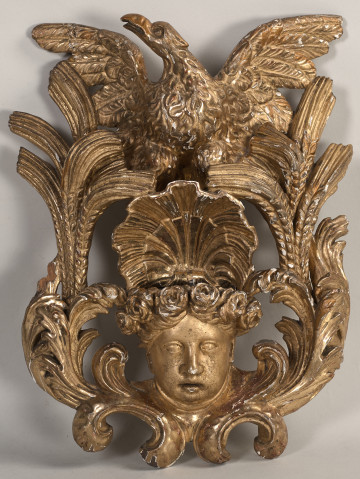
Stoup
18th century
Castle Museum in Łańcut
Part of the collection: Weapons, music instruments, varia
A household stoup (aspersorium) for hanging at the front door of a house or apartment, in our case the palace chapel. It was used for residents or guests to dip their fingers in holy water and make the sign of the cross. The stoup is made of gilded wood in the shape of a stylized heart with the image of the crucified Christ (at the top) and a shell-shaped container for holy water (at the bottom). The motif of shells often appeared in stoups, because, according to tradition, John the Baptist, while baptising people in the Jordan, used a shell for pouring water. The figure of Christ made in enamel painting, the cross in a rich frame of rococo gilded wood. The whole is attached to a wooden board in the shape of a coat of arms upholstered with burgundy velvet, at the top of the board there is a metal ring for hanging. Christ is depicted not as suffering but practically standing on the cross, the suffering evident only in the slight curvature of the mouth and the blood visible at the site of the pierced hands and feet, and near the heart. The stoup comes from the former equipment of the castle chapel and it certainly served all those who took part in the services held here. The castle chapel, located on the ground floor of the castle, was furnished in 1885 for Maria, née Sanguszko, wife of the Second Lord Ordynat of Łańcut, on the occasion of their wedding anniversary as a gift from their children (previously the chapel had been located on the first floor of the south-west tower). Holy water, the solemn consecration of which takes place on Easter Eve (Holy Saturday), is a sign of God’s presence, protects the home from evil and is an outward sign of confession of faith and rejection of Satan. Its prototype derives from the Old Testament – in front of the Tabernacle there was a copper pool used for ritual washing. The custom of using stoups was introduced by the church in the second century after Christ.
Author / creator
Dimensions
height: 60 cm, width: 3 cm
Object type
Weapons, instruments, varia
Technique
gilding, sculpture
Material
metal, wood, velvet
Creation time / dating
Creation / finding place
Owner
Castle Museum in Łańcut
Identification number
Location / status

18th century
Castle Museum in Łańcut

18th century
Castle Museum in Łańcut

19th (?) century
Castle Museum in Łańcut
DISCOVER this TOPIC
Museum of King Jan III's Palace at Wilanów
DISCOVER this PATH
Educational path